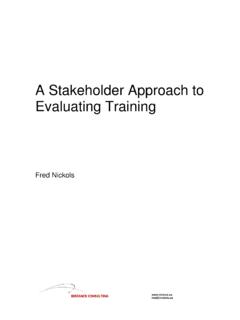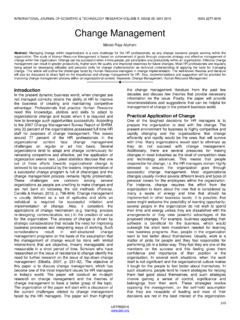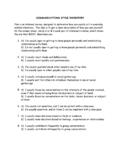Transcription of Four Strategies for Managing Change - Fred Nickols' Web Site
1 2016 four Strategies for Managing Change Fred Nickols four Strategies FOR Managing Change Fred Nickols 2016 Page 1 OV E R V I E W This paper presents four basic Strategies used to manage Change in and to organizations: 1. Empirical-Rational (E-R) 2. Normative-Reeducative (N-R) 3. Power-Coercive (P-C) 4. Environmental-Adaptive (E-A) The first three are summarized versions of classics from the work of Ken-neth Benne and Robert Chin1. The fourth is of the author s own making. Most successful Change efforts will require some mix of the four Strategies ; rarely will a single strategy suffice. The paper also provides some factors to consider in selecting a strategy or formulating a mix of Strategies . TH E EM P I R I C A L-RA T I O N A L ST R A T E G Y UN D E R L Y I N G AS S U M P T I O N S. People are rational beings and will follow their self-interest once it is revealed to them. Successful Change is based on the communication of information and the proffering of incentives.
2 For the most part, people are reasonable and they can be reasoned with. In short, they can be persuaded. Value judgments aside, they can also be bought. This is the carrot side of carrot-and-stick management. But for reason and incentives to work, there has to be very little in the way of a downside to the Change and/or the upside has to greatly outweigh it. If there s a big downside and it s not offset by an upside that is big enough and attractive enough to offset the downside and null out any risk involved, peo-ple will indeed be rational; that is, they will oppose or resist the Change overtly or covertly. SE L E C T I O N FA C T O R S. Change strategy here centers on the balance of in-centives and risk management. The Empirical-Rational strategy is difficult to deploy when the incentives available are modest. Why risk what we have for an uncertain future that promises to be no more than modestly better than the present?
3 This is es-pecially true when people currently have it pretty good. 1 General Strategies for Effecting Changes in Human Systems (1969) by Robert Chin and Kenneth D. Benne, Section of Chapter 1 in The Planning of Change (2nd Edition), Warren G. Bennis, Kenneth D. Benne and Robert Chin (Editors). Holt, Rine-hart & Winston: New York, NY. four Strategies FOR Managing Change Fred Nickols 2016 Page 2 One stratagem of use here is to cast doubt on the viability of the present state of affairs. You can attempt to convince people that they are on a burn-ing platform (not a good choice if they really aren t) or you can simply try to persuade them that the current state of affairs has a short shelf life. In either case, the story you tell has to convince them, not you. A by-product of the Rational-Empirical strategy consists of converts, that is, people who buy the story.
4 Some will see the light and want to sign on. These people can be very helpful. However, depending on their stature in the organization, you might not want them. Another stratagem here is to systematically target converts, that is, thought leaders and influencers who, if they buy the story and buy into helping make the Change , will influence others. TH E NO R M A T I V E-RE E D U C A T I V E ST R A T E G Y UN D E R L Y I N G AS S U M P T I O N S. People are social beings and will adhere to cultural norms and values. Successful Change is based on redefining and re-interpreting existing norms and values, and developing commitments to new ones. For the most part, most people do want to fit in and go along. They will go with the flow. The trick here is figuring out how to establish and define the flow. Again, set aside value judgments and you will see such common-place practices such as advertising, positioning, and so on.
5 Central here also is charismatic and dynamic leadership. It is also the case that the influence of the informal organization is felt strongly here, especially in the form of communities of practice. SE L E C T I O N FA C T O R S. The Normative-Reeducative strategy focuses squarely on culture what people believe about their world, their work and themselves and the ways in which people behave so as to be consistent with these beliefs. Ordinarily, culture doesn t Change quickly and certainly not overnight. This, then, is not the strategy of choice in a turnaround situation on short dead-lines. Moreover, an organization s culture is as much in the grip of the informal or-ganization as it is the formal organization. For this reason, the Normative-Reeducative strategy works best when relationships between the formal and informal organizations are at least cordial and hopefully harmonious. If they are at odds with one another, this Change strategy is denied to management.
6 four Strategies FOR Managing Change Fred Nickols 2016 Page 3 Still, there is an avenue or two open here. Almost all Change efforts have long-term as well as short-term goals. To some extent, any long-term Change strategy has to incorporate some aspects of the Normative-Reeducative strategy. Enlisting and involving the informal leaders of the or-ganization and keeping them involved is one such avenue. (It should be kept in mind that the formal and informal organizations often overlap in the form of people who lead or influence large or important constituencies and who also hold powerful positions.) TH E PO W E R-CO E R C I V E ST R A T E G Y UN D E R L Y I N G AS S U M P T I O N S. People are basically compliant and will gen-erally do what they are told or can be made to do. Successful Change is based on the exercise of authority and the imposition of sanctions. This can range from the iron hand in the velvet glove to downright brutality My way or the highway.
7 The basic aim here is to decrease people s op-tions, not increase them. Surprisingly, in many situations, people actually want and will readily accept a Power-Coercive strategy, particularly when all feel threatened and few know what to do. This strategy is the stick side of carrot-and-stick management. SE L E C T I O N FA C T O R S. Two major factors influencing the choice of the Power-Coercive strategy are time and the seriousness of the threat faced. If the organization sits astride the fabled burning platform, the threat is grave and the time for action is limited. The metaphor of a burning platform is useful but only if all concerned can in fact see that the platform is on fire. This is rarely the case in an organization. Few companies are filled with people who understand the way the business works and fewer people still appreciate the threats it faces or the opportunities it encounters. It has been argued that Change -minded leaders should create a burning plat-form.
8 That idea might have merit in extreme situations but it also entails considerable risk to the organization, to its people, and to the leader who attempts it. A mitigating factor here is the culture. If the culture is basically one of a be-nign bureaucracy that is clearly threatened, its members are likely to go along with a sensible program, no matter how high-handed. Conversely, if the culture is laced with autonomy and entrepreneurship but has grown fat, dumb and happy, people will resent and perhaps oppose or resist authori-tarian moves. In this case, key positions might have to be filled with new people. four Strategies FOR Managing Change Fred Nickols 2016 Page 4 TH E EN V I R O N M E NT A L-AD A P T I V E ST R A T E G Y UN D E R L Y I N G AS S U M P T I O N S. People oppose loss and disruption but they adapt readily to new circumstances. Change is based on building a new or-ganization and gradually transferring people from the old one to the new one.
9 This strategy shifts the burden of Change from management and the organi-zation to the people. It exploits their natural adaptive nature and avoids the many complications associated with trying to Change people or their culture. Essentially, this is a strategy of self-cannibalization, that is, you set out to eat your own lunch before someone else does. Also known as the die-on-the-vine strategy, the Environmental-Adaptive strategy hinges on the commonplace observation that, although people are often quick to oppose Change they view as undesirable, they are even quick-er to adapt to new environments. Consequently, instead of trying to trans-form existing organizations, it is often quicker and easier to create a new one and gradually move people from the old one to the new one. Once there, in-stead of being able to oppose Change , they are faced with the prospect of adapting to new circumstances, a feat they manage with great facility.
10 The old organization, then, is left to die on the vine. SE L E C T I O N FA C T O R S. The major consideration here is the extent of the Change . The Environmental-Adaptive strategy is best suited for situations where radical, transformative Change is called for. For gradual or incremen-tal Change , this is not the strategy of choice. Time frames are not a factor. This strategy can work under short time frames or longer ones. However, under short time frames, a key issue will be that of Managing what could be explosive growth in the new organization and, if it is not adequately seeded with new folks, the rapid influx of people from the old culture can infuse the new organization with the old culture. Another factor to consider is the availability of suitable people to seed the new organization and jump-start its culture. Some can come from other or-ganizations but some can come from the old organization, too.















